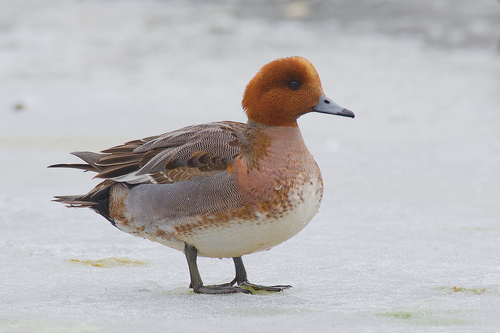
Eurasian Wigeon
The Eurasian Wigeon (*Mareca penelope*) is a medium-sized dabbling duck known for its striking appearance and widespread distribution across Eurasia. It plays a crucial role in wetland ecosystems as a grazer and seed disperser. Unlike many duck species, the male Eurasian Wigeon has a distinctive whistling call, rather than a quack. While not holding particular cultural significance in the same way as some iconic birds, it is a popular species among birdwatchers and a game bird in some regions.
42-50 cm
Length
75-86 cm
Wingspan
Least Concern
Conservation Status
Distribution
Breeds across northern Europe and Asia, from Iceland and the British Isles eastwards to Siberia and Kamchatka. Winters further south in southern Europe, North Africa, the Middle East, the Indian subcontinent, and Southeast Asia. Migratory routes vary, with some populations undertaking long-distance migrations.
Lifespan
Typically 3-5 years in the wild, although individuals can live longer. Records of over 20 years exist in captivity.
Eurasian Wigeon's Habitat
Habitat Types
Freshwater wetlands, Coastal marshes, Estuaries, Flooded grasslands, Lakes, Reservoirs
Climate Zones
Temperate, Boreal, Subarctic, Mediterranean
Adaptations
Eurasian Wigeons are well-adapted to grazing, with a relatively short, strong bill suited for tearing vegetation. Their webbed feet provide efficient propulsion in water.
Variations
No widely recognized subspecies exist, although some minor regional variations in plumage and size have been observed.
Appearance
Breeding Plumage
Breeding males have a chestnut head with a creamy-yellow forehead, pinkish breast, and gray body. Non-breeding males (eclipse plumage) resemble females. Females are mottled brown overall.
Seasonal Feather Changes
Males undergo a complete molt after breeding, adopting the eclipse plumage. They regain their breeding plumage in the autumn.
Sex Based Plumage Differences
Significant dimorphism. Males are brightly colored in breeding plumage, while females are camouflaged.
Notable Features
Rounded head shape, Short, blue-gray bill with a black tip, Distinctive whistling call of the male
Diet and Feeding
Primary Foods
Grasses, Sedges, Aquatic plants, Seeds, Roots, Tubers
Foraging Behavior
Primarily grazes on land, often in fields and meadows near water. Also dabble in shallow water, upending to reach submerged vegetation.
Specializations
The bill's structure is adapted for efficient grazing, allowing the bird to quickly tear and consume vegetation.
Seasonal Diet Variations
Diet shifts slightly depending on food availability. May consume more seeds and invertebrates during the breeding season.
Behavior
Social Structure
Highly gregarious outside of the breeding season, often forming large flocks. Forms pairs during the breeding season.
Communication
Male's distinctive whistling call ('whee-oo'), Female's low grunts and quacks, Visual displays during courtship and territorial defense
Migration
Migratory, with populations breeding in northern latitudes moving south for the winter. Migration is often nocturnal, and birds fly in large flocks.
Territorial or Group Behaviors
Males defend territories around the nest during the breeding season. Outside of breeding, they are highly social and form large flocks for feeding and roosting.
Conservation
Threats
Habitat loss and degradation (wetland drainage and agricultural intensification), Hunting pressure in some regions, Climate change (affecting breeding and wintering habitats), Lead poisoning from ingestion of spent shot
Protection Programs
African-Eurasian Waterbird Agreement (AEWA), Ramsar Convention on Wetlands, Various national and regional conservation initiatives
Local National Laws
Protected under various national wildlife laws across its range, with regulations on hunting.
Population Trend
Stable
Population Estimates
Estimated global population of 2.8 - 3.3 million individuals.
Interesting Facts
The Eurasian Wigeon's whistling call is often described as sounding like 'whee-oo'.
This distinctive call helps distinguish it from other duck species.
They are known to steal food from other birds.
Eurasian Wigeons sometimes engage in kleptoparasitism, snatching food from other ducks and waterbirds.
They can hybridize with other duck species.
Though rare, hybrids with species like the American Wigeon have been recorded.
Faqs about Eurasian Wigeon
What is the difference between a Eurasian Wigeon and an American Wigeon?
The most obvious difference is the head color of the breeding male. Eurasian Wigeons have a chestnut head with a yellow forehead, while American Wigeons have a gray head with a green stripe.
Where can I see Eurasian Wigeons?
During the winter, they can be found on wetlands, lakes, and coastal areas throughout Europe, Asia, and parts of North Africa. During the breeding season, they are found further north.
Are Eurasian Wigeons endangered?
No, they are classified as Least Concern by the IUCN, meaning they are not currently considered to be at risk of extinction.
Do Eurasian Wigeon migrate?
Yes, Eurasian Wigeons are migratory birds. They breed in northern regions of Europe and Asia and migrate south for the winter to warmer climates.
Copyright @ Nature Style Limited. All Rights Reserved.
 English
English